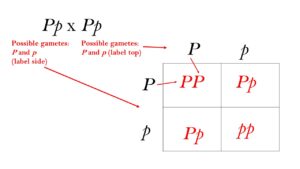Monohybrid Cross Calculator
Enter the genotype of each parent (e.g., Aa, AA, aa):
Monohybrid Cross Calculator – Predict Simple Genetic Traits
Our Monohybrid Cross Calculator helps you quickly determine the genotypic and phenotypic outcomes of a genetic cross involving a single trait. Whether you’re a student, educator, or enthusiast, this tool offers a fast and interactive way to learn inheritance patterns. Explore quick and accurate inheritance calculators on our main site.
What Is a Monohybrid Cross?
A monohybrid cross is a genetic cross between two individuals focusing on one trait. Each parent carries two alleles for the same gene, and the offspring inherit one allele from each parent.
For example, if both parents have genotype Aa (heterozygous), the resulting Punnett Square shows a 1:2:1 genotypic ratio and a 3:1 phenotypic ratio if A is dominant.

How to Use This Calculator
- Input two-letter genotypes for both parents (e.g., AA, Aa, or aa).
- Click the “Calculate” button.
- View genotype probabilities with counts and percentages.
For example, if both parents have genotype Aa (heterozygous), the resulting Punnett Square shows a 1:2:1 genotypic ratio and a 3:1 phenotypic ratio if A is dominant.
Educational Applications of Monohybrid Crosses
- Understanding dominant and recessive allele inheritance
- Predicting disease carriers and affected offspring
- Exploring Mendelian genetics in biology class
Genotypic & Phenotypic Ratio Explanation
Genotype: The actual allele combination (e.g., AA, Aa, aa)
Phenotype: The observable trait (e.g., tall, short)
This calculator assumes simple Mendelian inheritance where one allele is dominant (A) and the other recessive (a).
FAQs – Monohybrid Crosses
What if I enter an invalid genotype?
The calculator accepts only two-letter genotypes like AA, Aa, or aa. It will prompt you for correct input if the format is wrong.
Can I do more complex crosses?
Yes! Try the Dihybrid Cross Calculator.
Is this tool suitable for classroom use?
Absolutely. This tool is designed for both students and educators to demonstrate basic Mendelian inheritance patterns.
